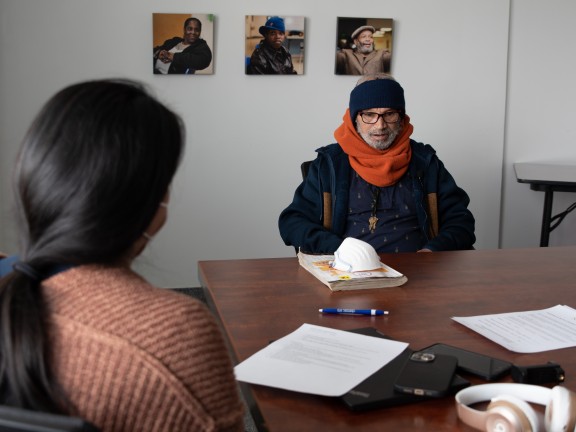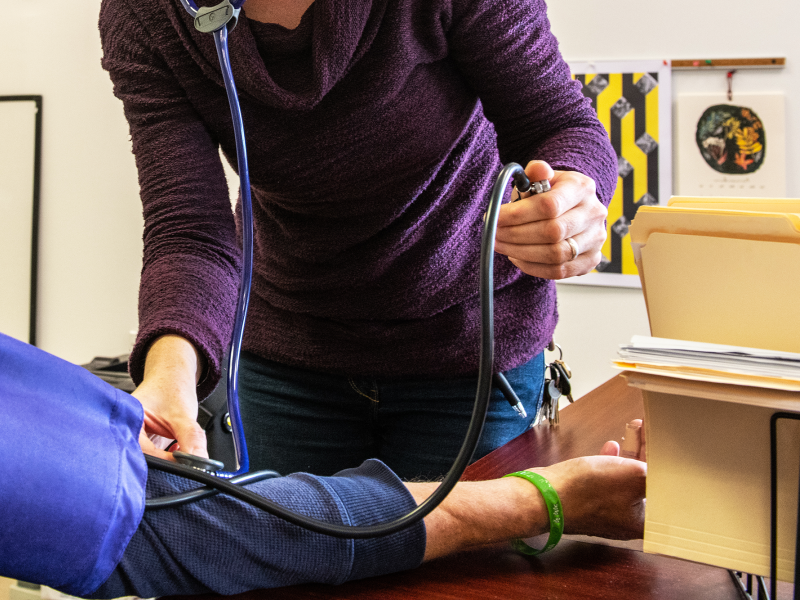Five Ways to Spot a Fake “Expert” on Homelessness

Housing First is not a new idea. Pioneered in New York City in the 1990s, it was first included in federal recommendations under the George W. Bush administration, received bipartisan support in Congress for years, and contributed to an impressive 25.69% reduction in homelessness nationwide between 2005 and 2018. However, following the Trump administration’s call to reverse Obama-era Housing First policies ahead of the 2020 election, we’ve seen the issue of homelessness become increasingly politicized.
In the last two years, the widely used, evidence-based Housing First model has become the primary target for many conservative think tanks. But often the “experts” staffing these groups are journalists and researchers who have never worked a single day in homeless services, never mind a Housing First program. They’ve never conducted street outreach, helped an individual move into their new home, or accompanied someone to a medical or behavioral health appointment. Moreover, their arguments rely on a dishonest oversimplification of the problem of homelessness. Here are the top five signs that that “expert” on Housing First doesn’t actually know what they’re talking about:
- “Housing First is a one-size-fits-all solution.”
Anyone who has spent time working in Housing First program knows that the Housing First model is highly individualized. This is what makes it so hard to implement, but also what makes it so successful. Rather than funneling each participant through a set of rigid treatment protocols, we carefully consider each person’s strengths, barriers, trauma history, and resources as we help them to develop a treatment plan that meets their specific needs. By no surprise, this also increases participant buy-in!
Of course, the challenge with this approach is that there is no way to know exactly how the program will unfold for each individual receiving services. This is because we are centering participant goals and promoting choice, self-determination, and autonomy every step of the way. We start by providing someone with a home, but everything that comes after will be based on an individual’s self-identified goals, priorities, and timeline. We trust that our participants are the experts on their own lives and experiences, and offer multiple service options to meet their needs. This work takes immense patience, creativity, and flexibility and is a key reason for the use of multidisciplinary treatment teams.
Folks who say “Housing First is a one-size-fits-all solution” get one thing right, however. Housing First can work for anyone. Since the model was developed to help the most underserved individuals in our system (those experiencing chronic homelessness, living with severe persistent mental illness, and/or substance use disorders), we know that providing a home, as well as flexible and mobile wrap-around supports, can end homelessness for any population.
- “Housing First programs don’t address mental illness or substance use disorders.”
Also known as the “Housing First = Housing only” argument.
The name Housing First says it all. Something must come next! If a program provides housing without the necessary wrap-around supports to help tenants maintain their housing successfully, it’s NOT Housing First. Funding housing but not the required Assertive Community Treatment (ACT) or Intensive Case Management (ICM) services prescribed by the model, will leave you and your program participants sorely disappointed.
All participants in a Housing First program are required to receive regular visits from trained case managers in their homes. The home visit serves three purposes— to ensure the individual is doing well, to ensure the unit is in good condition, and to observe how the individual is managing as a tenant. We utilize a harm reduction approach to care, prioritizing safety and bodily autonomy, while celebrating any positive change towards increased health and wellness. The home visit serves as an opportunity to continually invite participants into the treatment process, but our staff recognizes this will take time, patience, and trust.
At Pathways to Housing PA, we’ve seen incredible outcomes for those with co-occurring disorders. 72% of our 550 program participants are engaged in on-site medical and behavioral health care, and 80% of our participants with Opioid Use Disorder are engaged in some form of substance use treatment within six months of getting housed with us (four times the national average). Our clinical teams also support participants with gaining employment, reconnecting with friends and family, financial management, socially reintegrating into the community, and countless other areas to support holistic recovery.
- “This [program/county/city/etc.] tried Housing First, and it didn’t work.”
High-fidelity Housing First programs consistently report significantly higher housing retention rates than traditional housing programs requiring sobriety and other forms of “housing readiness.” Those who claim Housing First failed in their community most assuredly cherry-picked the easiest parts of Housing First to implement, which will unsurprisingly provide poorer outcomes.
High-fidelity Housing First programs adhere to 38 fidelity principles across five categories: Housing Choice and Structure, Separation of Housing and Services, Service Philosophy, Service Array, and Program Structure. Examples include:
- 1.5. Program participants live in scattered-site private market housing which is otherwise available to people without psychiatric or other disabilities.
- 2.12. Program staff are not located at participants’ residences and are mobile, with the ability to deliver services in locations of participants’ choosing.
- 3.13. Program participants choose the type, sequence, and intensity of services on an ongoing basis.
- 4.27. Nursing services are provided directly by the program.
- 5.32. Program consistently maintains a low participant staff ratio (10:1) excluding the psychiatrist and administrative support.
Programs can perform a self-assessment for each of the 38 principles—rating their adherence to each as “always” (3), “sometimes” (2), or “not at all” (1). The closer your program scores to 114 (3x38), the higher the fidelity to the program model, and the higher your housing retention rates and other favorable participant outcomes will be.
- “Housing First hasn’t solved homelessness. In fact, it’s worsening the problem.”
Those who blame the increase in homelessness on the Housing First model are willfully ignorant, at best, or intentionally misleading, at worst. While it’s true that the number of individuals experiencing homelessness has increased by approximately 5.36% since 2018, the total number of individuals experiencing homelessness has actually decreased by 9.42% since 2009, when President Obama signed the Homeless Emergency Assistance and Rapid Transition to Housing (HEARTH) Act into law, paving the way for wider adoption of the Housing First model in the United States.
Arguments against the Housing First model as a sustainable solution to ending homelessness imply that the increase in overall homeless is due to individuals who have returned to the streets after failing to achieve sobriety in Housing First programs. However, this reporting deliberately ignores individuals who are newly homeless.
For anyone with the ability to read and think critically, new instances of homelessness should come as no surprise. The federal minimum wage has remained stagnant at $7.25 per hour since 2009, while housing costs have risen by 107% in that same time frame. 54% of that increase has occurred within the last five years alone. Other contributing factors include inflation, unemployment, the impact of the Covid-19 pandemic, exclusionary zoning laws, and a decrease in the availability of affordable housing.
- “Housing First programs cost taxpayers too much money.”
It actually costs us less to house a person than it does to let them continue to be homeless. If you add up all of the potential costs involved with a person living unsheltered (ambulance services, emergency department visits, police interventions, jail, and prison stays, medical and psychiatric hospitalizations, soup kitchens, shelter nights, etc.), it averages out to be much more than the cost of subsidizing rent and providing appropriate services. In fact, Housing First can save the public between $900-$29,400 per person per year.
On average it costs more than $155 a night for inpatient rehabilitation services, $113 a night to house an individual in congregate housing, but only $80 a night to house an individual through the Housing First model. A 2011 study of Pathways to Housing PA by Fairmount Ventures, Inc. showed that our program is less expensive per person than comparable programs serving the same population. We’re half the cost of permanent housing programs for individuals experiencing chronic homelessness using a “treatment first” approach, and about two-thirds the cost of residential drug and alcohol treatment programs for folks experiencing chronic homelessness and mental illness.
The Fairmount Ventures study also showed that, after getting housed, our participants saw an 88% decrease in costly shelter episodes, a 71% decrease in Crisis Response Center episodes, a 70% decrease in psychiatric hospitalizations, and a 50% decrease in Philadelphia Prison System episodes. If you couple this with the fact that Housing First agencies are renting vacant market-rate apartments and helping to retain the local tax base, you've got a win/win! Housing First services are good for the person who is now housed, and good for our community as a whole.
Once you know even the basics of Housing First, it’s easy to spot a fake “expert.” Educating ourselves, dispelling common myths, and advocating for the Housing First approach to ending homelessness in our communities is vital work.


